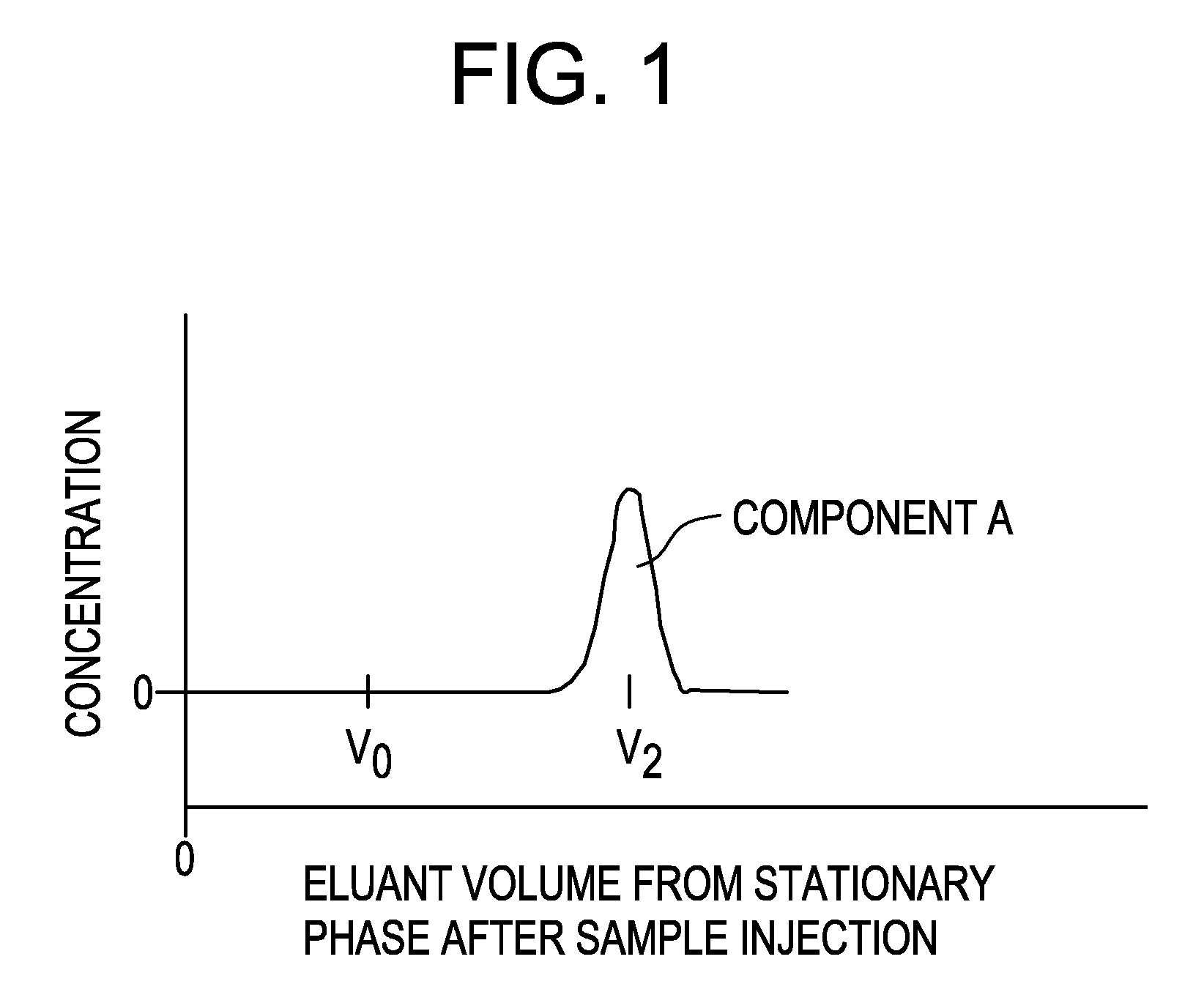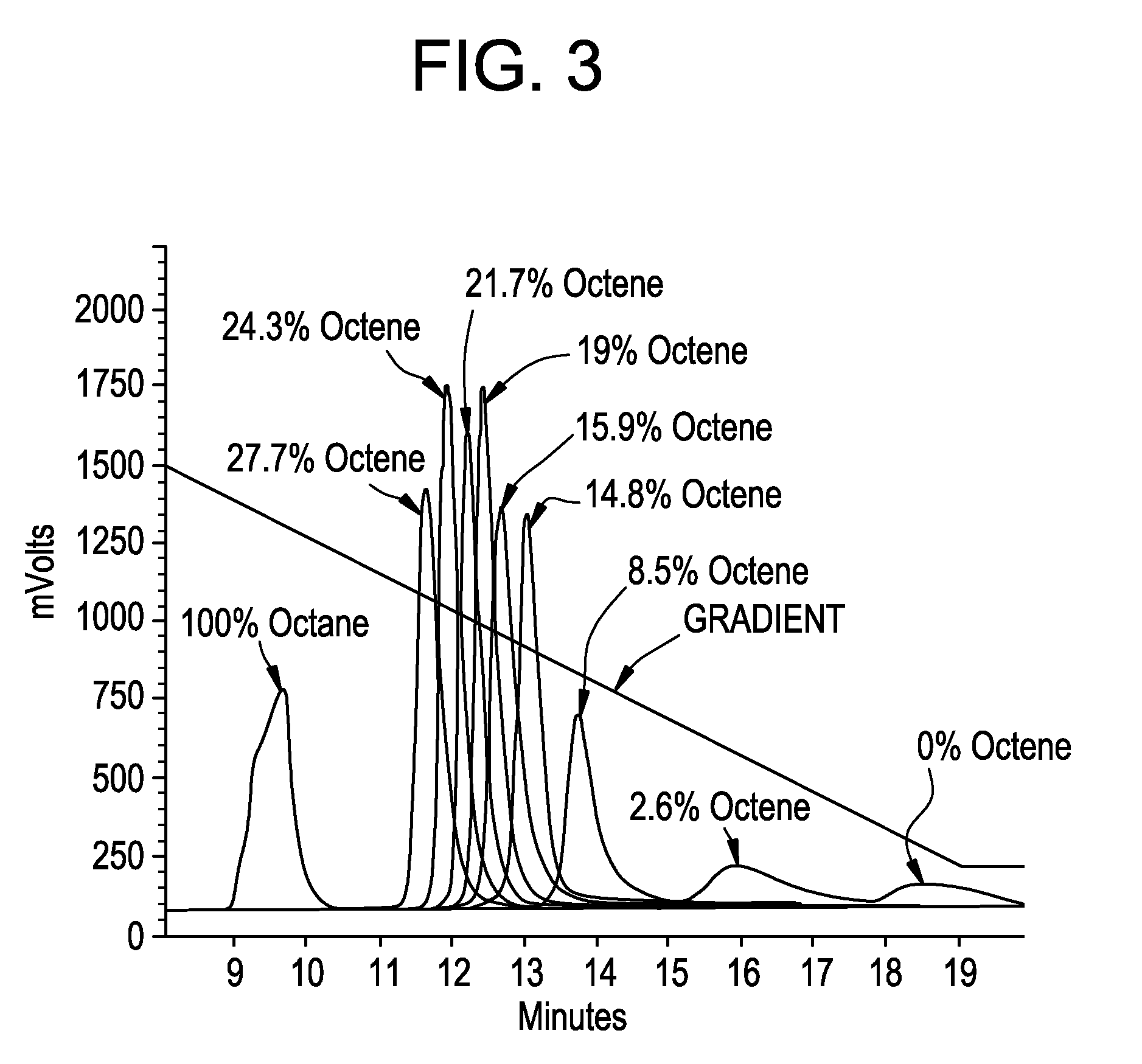Chromotography of polyolefin polymers
a polyolefin polymer and chromophore technology, applied in the field of liquid chromatography, can solve the problems of limited separation efficiency obtained by prior art methods, tref and crystaf cannot be used to analyze amorphous polyolefin polymers, and the analysis time of tref and crystaf is relatively long, so as to improve separation efficiency
- Summary
- Abstract
- Description
- Claims
- Application Information
AI Technical Summary
Benefits of technology
Problems solved by technology
Method used
Image
Examples
example 1
[0033]An HPLC system is assembled using a 4.6×100 mm, 5 micrometer packing size, 250 Å pore size, HYPERCARB brand liquid chromatography column, a gradient composition mobile phase at a flow rate of 1.0 milliliters per minute having an initial composition of 100 vol. % ethylene glycol mono butyl ether for 3 minutes after injection and then a 15 minute linear gradient composition change to 100 vol. % 1,2,4-trichloro benzene followed by a 3 minute hold at 100 vol. % 1,2,4-trichloro benzene, an injection volume of 10 micro liters, a sample concentration of 2 milligrams of polymer per milliliter of 160° C. decanol, a column temperature of 140° C., an injection valve temperature of 160° C., a Polymer Laboratories (Amherst, Mass.) ELS-1000 evaporative light scattering detector operated with a gas flow of 1.4 liters per minute, a nebulation temperature of 200° C. and an evaporation temperature of 250° C. Ten samples of copolymers of various mole ratios of polymerized ethylene and 1-octene m...
example 2
[0034]An HPLC system is assembled using a 4.6×100 mm, 5 micrometer packing size, 250 Å pore size, HYPERCARB brand liquid chromatography column, a gradient composition mobile phase at a flow rate of 1.0 milliliters per minute having an initial composition of 100 vol. % ethylene glycol mono butyl ether for 3 minutes after injection and then a 15 minute linear gradient composition change to 100 vol. % 1,2,4-trichloro benzene followed by a 3 minute hold at 100 vol. % 1,2,4-trichloro benzene, an injection volume of 10 micro liters, a sample concentration of 2 milligrams of polymer per milliliter of 160° C. decanol, a column temperature of 140° C., an injection valve temperature of 160° C., a Polymer Laboratories (Amherst, Mass.) ELS-1000 evaporative light scattering detector operated with a gas flow of 1.4 liters per minute, a nebulation temperature of 200° C. and an evaporation temperature of 250° C. Ten samples of copolymers of various mole ratios of polymerized ethylene and propylene ...
example 3
[0035]An HPLC system is assembled using a 4.6×50 mm, 5 micrometer packing size, DISCOVERY ZR-CARBON brand liquid chromatography column, a gradient composition mobile phase at a flow rate of 1.0 milliliters per minute having an initial composition of 100 vol. % ethylene glycol mono butyl ether for 3 minutes after injection and then a 15 minute linear gradient composition change to 100 vol. % 1,2,4-trichloro benzene followed by a 3 minute hold at 100 vol. % 1,2,4-trichloro benzene, an injection volume of 10 microliters, a sample concentration of 2 milligrams of polymer per milliliter of 160° C. decanol, a column temperature of 140° C., an injection valve temperature of 160° C., a Polymer Laboratories (Amherst, Mass.) ELS-1000 evaporative light scattering detector operated with a gas flow of 1.4 liters per minute, a nebulation temperature of 200° C. and an evaporation temperature of 250° C. Ten samples of copolymers of various mole ratios of polymerized ethylene and 1-octene monomers a...
PUM
| Property | Measurement | Unit |
|---|---|---|
| concentration | aaaaa | aaaaa |
| concentration | aaaaa | aaaaa |
| pore size | aaaaa | aaaaa |
Abstract
Description
Claims
Application Information
 Login to View More
Login to View More - R&D
- Intellectual Property
- Life Sciences
- Materials
- Tech Scout
- Unparalleled Data Quality
- Higher Quality Content
- 60% Fewer Hallucinations
Browse by: Latest US Patents, China's latest patents, Technical Efficacy Thesaurus, Application Domain, Technology Topic, Popular Technical Reports.
© 2025 PatSnap. All rights reserved.Legal|Privacy policy|Modern Slavery Act Transparency Statement|Sitemap|About US| Contact US: help@patsnap.com



